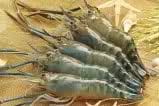 Shrimp is the most important commodity, by value, in the international seafood trade. The shrimp industry has grown exponentially in the last decades, and growth is expected to continue for years to come.
Shrimp is the most important commodity, by value, in the international seafood trade. The shrimp industry has grown exponentially in the last decades, and growth is expected to continue for years to come.
A new and better technology to culture shrimps is being used by many enterprising shrimp farmers nowadays. Green water technology is a technique that cultures shrimps in water that is abundant in phytoplankton i.e. Chlorella, turning the water green hence, its name.
Pond Preparation
To prepare the pond, it should be dried and drained of water for three weeks until the soil at the bottom is cracked. The muck or the black soil at the bottom of the pond should be scraped off. Then the ponds are flooded with water and dried for another week. Hydrated lime at a rate of 2 tons per hectare is applied before the final flushing and sun drying.
When the pond is clean and dry, double hapa nets (10×10×1.5 meters) should be installed at the center of the pond. Bamboo catwalks from the dikes to the pens should be installed to facilitate easy feeding and monitoring of fish.
Water Culture/ Fertilization
After installing the pens, the ponds should be filled with seawater to a maximum depth of 1.0-1.2 meters and the gates should be sealed. The water depth should be maintained by installing a depth gauge. To make sure that the water is free from predators and other possible competitors, teaseed powder (20 ppm) should be applied. Fine mesh screens should be installed at each outlet of the flume to prevent predators from entering the pond during pumping.
Stocking and Stock Sampling
To check the growth and condition of the shrimps, the stock should be sampled after 30 days from culture and every 10 days thereafter.
Feeding Management
For shrimps, they should be fed right after stocking. Shrimp feeds are broadcasted around the pond with a portion of the feeding ration left in the feeding trays. Four trays measuring 0.25 square meter should be installed to monitor the amount of feeds consumed everyday. During the first 30 days, blind feeding is practiced. About 200 grams of feed per 10,000 postlarvae is given. One to three hours after feeding, the trays are lifted and the amount of feed consumed is estimated. From 40 days of culture, the shrimps are fed five times a day, i.e., 6:00 AM. 10:00 A.M., 2:00 P.M., 5:00 P.M. and 10:00 P.M. at 20%, 10%, 10%, 35%, and 25%, respectively of the total feeding ration.
Water Management and Aeration
After 30 days of culture, 10-20% of the water in the pond is drained and replaced with water from the reservoir ponds. It should be noted that the water from the reservoir ponds should be allowed to stay for at least 4-5 days before they are used to replenish the water in the shrimp rearing ponds.
The ideal amount of dissolved oxygen is maintained by using six paddlewheel aerators. In the first 60 days, only four aerators are alternately operated for 24 hours. Another aerator is installed in each tilapia pen to increase the circulation of water and phytoplankton in and out of the pens.
Harvest and Post-Harvest Handling
Shrimps are harvested when they weigh at least 30 grams. Harvesting is done by draining the water and collecting the shrimps using a harvest net installed at the pond gate. The collected shrimps are placed in water with crushed ice to maintain their quality. The shrimps are then sorted according to size and placed in boxes with crushed ice to be shipped to shrimp processing plants where they are packed for export purposes.
Sources: bar.gov.ph. http://www.bar.gov.ph/agfishtech/fish/shrimp.asp. Sept 2009. Photo:www.fistenet.gov.vn
PCAMRD – Philippine Council for Aquatic and Marine Research and Development
Department of Science and Technology (DOST
Jamboree rd., Brgy. Timugan, Los Baños, Laguna
Tel. No.: (049) 536-5578, 536-5579, 536-1574
Telefax: (049) 536-1582
E-mail: pcamrd@laguna.net
PCAMRD Liaison Office
2nd Floor, Rm. 205 PTRI Bldg.
Gen. Santos Ave., Bicutan, Taguig, Metro Manila, Philippines
Telephone Number: (63 2) 837-2071 up to 82 local 2430
Web: www.pcamrd.dost.gov.ph
BFAR – Bureau of Fisheries and Aquatic Resources
Arcadia Building
860 Quezon Avenue
1103 Quezon City, Philippines
Tel No. : +63(2)3725043
Fax No. : +63(2)3725048
Email : info@bfar.da.gov.ph
Web: http://www.bfar.gov.ph
Do you like this aqua business idea? then please consider subscribing to our PINOY BISNIS ![]() RSS feed. You can also subscribe by email and have new articles sent directly to your inbox.
RSS feed. You can also subscribe by email and have new articles sent directly to your inbox.
can this green water system be used in swimming pools.